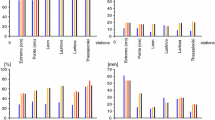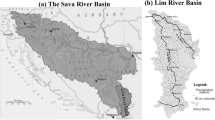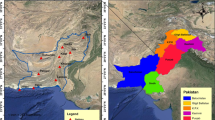Abstract
The weather research and forecast (WRF) model downscaling skill in extreme maximum daily temperature is evaluated by using the generalized extreme value (GEV) distribution. While the GEV distribution has been used extensively in climatology and meteorology for estimating probabilities of extreme events, accurately estimating GEV parameters based on data from a single pixel can be difficult, even with fairly long data records. This work proposes a simple method assuming that the shape parameter, the most difficult of the three parameters to estimate, does not vary over a relatively large region. This approach is applied to evaluate 31-year WRF-downscaled extreme maximum temperature through comparison with North American regional reanalysis (NARR) data. Uncertainty in GEV parameter estimates and the statistical significance in the differences of estimates between WRF and NARR are accounted for by conducting a novel bootstrap procedure that makes no assumption of temporal or spatial independence within a year, which is especially important for climate data. Despite certain biases over parts of the United States, overall, WRF shows good agreement with NARR in the spatial pattern and magnitudes of GEV parameter estimates. Both WRF and NARR show a significant increase in extreme maximum temperature over the southern Great Plains and southeastern United States in January and over the western United States in July. The GEV model shows clear benefits from the regionally constant shape parameter assumption, for example, leading to estimates of the location and scale parameters of the model that show coherent spatial patterns.








Similar content being viewed by others
References
Bell JL, Sloan LC, Snyder MA (2004) Regional changes in extreme climatic events: a future climate scenario. J Clim 17:81–87
Beniston M (2004) The 2003 heat wave in Europe: a shape of things to come? An analysis based on Swiss climatological data and model simulations. Geophys Res Lett 31:L02202. doi:10.1029/2003GL018857
Bowden JH, Otte TL, Nolte CG, Otte MJ (2012) Examining interior grid nudging techniques using two-way nesting in the WRF model for regional climate modeling. J Clim 25:2805–2823
Brown SJ, Caesar J, Ferro CTA (2008) Global changes in extreme daily temperature since 1950. J Geophys Res 113:D05115. doi:10.1029/2006JD008091
Bukovsky MS, Karoly DJ (2007) A brief evaluation of precipitation from the North American regional reanalysis. J Hydrometeorol 8:837–846
Coles SG (2001) An introduction to statistical modeling of extreme values. Springer, London
Cooley D, Sain S (2010) Spatial hierarchical modeling of precipitation extremes from a regional climate model. J Agric Bio Environ Stat 15(3):381–402
Cooley D, Nychka D, Naveau P (2007) Bayesian spatial modeling of extreme precipitation levels. J Am Stat Assoc 102:824–840
Craigmile PF, Guttorp P (2013) Can a regional climate model reproduce observed extreme temperatures? Statistica 73(1):103–122
Daly C, Neilson RP, Phillips DL (1994) A statistical-topographic model for mapping climatological precipitation over mountainous terrain. J Appl Meteorol 33:140–158
Daly C, Halbleib M, Smith JI, Gibson WP, Doggett MK, Taylor GH, Curtis J, Pasteris PP (2008) Physiographically sensitive mapping of climatological temperature and precipitation across the conterminous United States. Int J Climatol 28:2031–2064
Di Luca A, de Elía R, Laprise R (2013) Potential for added value in temperature simulated by high-resolution nested RCMs in present climate and in the climate change signal. Clim Dyn 40:443–464. doi:10.1007/s00382-012-1384-2
Dole R, Hoerling M, Perlwitz J, Eischeid J, Pegion P, Zhang T, Quan X-W, Xu T, Murray D (2011) Was there a basis for anticipating the 2010 Russian heat wave? Geophys Res Lett 38:L06702. doi:10.1029/2010GL046582
Durman CF, Gregory JM, Hassell DC, Jones RG, Murphy JM (2001) A comparison of extreme European daily precipitation simulated by a global and regional climate model for present and future climates. Q J R Meteorol Soc 127:1005–1015
Easterling DR et al (2000) Climate extremes: observations, modeling, and impacts. Science 289:2068–2074
Field CB et al (2012) Managing the risks of extreme events and disasters to advance climate change adaptation. IPCC Special Report. www.ipcc-wg2.gov/SREX/
Fita L, Fernández J, García-Díez M (2010) CLWRF: WRF modifications for regional climate simulation under future scenarios. In: Extended abstracts of the 11th WRF users’ workshop, Boulder, 21–25 June 2010, pp 1–4
Fowler HJ, Ekstrom M, Kilsby CG, Jones PD (2005) New estimates of future changes in extreme rainfall across the UK using regional climate model integrations. 1. Assessment of control climate. J Hydrol 300:212–233
Frei C, Scholl R, Schmidli J, Fukutome S, Vidale PL (2006) Future change of precipitation extremes in Europe: an intercomparison of scenarios from regional climate models. J Geophys Res 111:D06105. doi:10.1029/2005JD005965
Gao Y, Fu JS, Drake JB, Liu Y, Lamarque JF (2012) Projected changes of extreme weather events in the eastern United States based on a high resolution climate modeling system. Environ Res Lett 7(4):044025. doi:10.1088/1748-9326/7/4/044025
Hasan HB, Ahmad Radi NFB, Kassim SB (2012) Modeling of extreme temperature using generalized extreme value (GEV) distribution: a case study of Penang. In: Proceedings of the world congress on engineering, vol I WCE 2012, July 4–6, London
Hong SY, Lim JJ (2006) The WRF single-moment 6-class microphysics scheme (WSM6). J Korean Meteorol Soc 42:129–151
Hosking JRM (1990) L-moments: analysis and estimation of distributions using linear combinations of order statistics. J R Stat Soc B 52:105–124
Hosking JRM (1992) Moments or L moments? An example comparing two measures of distributional shape. Am Stat 46(3):186–189. doi:10.2307/2685210
Hosking JRM (2006) On the characterization of distributions by their L-moments. J Stat Plan Inference 136:193–198
Hosking JRM, Wallis JR (1988) The effect of intersite dependence on regional flood frequency analysis. Water Resour Res 24:588–600
Hosking JRM, Wallis JR (1997) Regional frequency analysis: an approach based on L-moments. Cambridge University Press, Cambridge
Kain JS (2004) The Kain–Fritsch convective parameterization: an update. J Appl Meteorol 43:170–181
Kain JS, Fritsch JM (1990) A one-dimensional entraining/detraining plume model and its application in convective parameterization. J Atmos Sci 47:2784–2802
Kain JS, Fritsch JM (1993) Convective parameterization for mesoscale models: the Kain–Fritsch scheme. The representation of cumulus convection in numerical models. Meteorol Monogr 24:165–170
Kanamaru H, Kanamitsu M (2007) 57-year California reanalysis downscaling at 10 km (CaRD10) Part II. Comparison with North American Regional Reanalysis. J Clim 20:5553–5571
Kanamitsu M, Ebisuzaki W, Woollen J, Yang S-K, Hnilo JJ, Fiorino M, Potter GL (2002) NCEP–DOE AMIP-II reanalysis (R-2). Bull Am Meteorol Soc 83:1631–1643
Katz RW, Craigmile PF, Guttorp P, Haran M, Sansó B, Stein M (2013) Uncertainty analysis in climate change assessments. Nat Clim Change 3:769–771
Kharin VV, Zwiers FW (2005) Estimating extremes in transient climate change simulations. J Clim 18:1156–1173
Kharin VV, Zwiers FW, Zhang X, Hegerl GC (2007) Changes in temperature and precipitation extremes in the IPCC ensemble of global coupled model simulations. J Clim 20:1419–1444
Leadbetter MR, Lindgren G, Rootzén H (1983) Extremes and related properties of random sequences and processes. Statistics series. Springer, Berlin
Liu P, Tsimpidi AP, Hu Y, Stone B, Russell AG, Nenes A (2012) Differences between downscaling with spectral and grid nudging using WRF. Atmos Chem Phys 12:3601–3610
Loikith PC, Lintner BR, Kim J, Lee H, Neelin JD, Waliser DE (2013) Classifying reanalysis surface temperature probability density functions (PDFs) over North America with cluster analysis. Geophys Res Lett 40:3710–3714. doi:10.1002/grl.50688
Mannshardt E, Craigmile PF, Tingley MP (2013) Statistical modeling of extreme value behavior in North American tree-ring density series. Clim Change 117:843–858
Meehl GA, Tebaldi C (2004) More intense, more frequent, and longer lasting heat waves in the 21st century. Science 305:994–997
Meehl GA et al (2007) Climate change 2007: the physical science basis. Contribution of working group I to the fourth assessment report of the Intergovernmental Panel on Climate Change. Cambridge University Press, Cambridge, pp 747–845
Mesinger F et al (2006) North American regional reanalysis. Bull Am Meteorol Soc 87:343–360
Miguez-Macho G, Stenchikov GL, Robock A (2004) Spectral nudging to eliminate the effects of domain position and geometry in regional climate model simulations. J Geophys Res 109:D13104. doi:10.1029/2003JD004495
Morrison H, Thompson G, Tatarskii V (2009) Impact of cloud microphysics on the development of trailing stratiform precipitation in a simulated squall line: comparison of one- and two-moment schemes. Mon Weather Rev 137:991–1007. doi:10.1175/2008MWR2556.1
Murari KK, Ghosh S, Patwardhan A, Daly E, Salvi K (2015) Intensification of future severe heat waves in India and their effect on heat stress and mortality. Reg Environ Change 15(4):569
Otte TL, Nolte CG, Otte MJ, Bowden JH (2012) Does nudging squelch the extremes in regional climate modeling? J Clim 25:7046–7066
Papalexiou SM, Koutsoyiannis D (2013) Battle of extreme value distributions: a global survey on extreme daily rainfall. Water Resour Res 49(1):187–201. doi:10.1029/2012WR012557
Perkins SE, Pitman AJ, Sisson SA (2009) Smaller projected increases in 20-year temperature returns over Australia in skill-selected climate models. Geophys Res Lett 36:L06710. doi:10.1029/2009GL037293
Pielke RA (2002) Mesoscale meteorological modeling, 2nd edn. Academic Press, San Diego
Rahmstorf S, Coumou D (2011) Increase of extreme events in a warming world. Proc Natl Acad Sci 108:17905–17909
Schär C, Vidale PL, Lüthi D, Frei C, Häberli C, Liniger MA, Appenzeller C (2004) The role of increasing temperature variability in European summer heatwaves. Nature 427:332–336. doi:10.1038/nature02300
Schliep EM, Cooley D, Sain SR, Hoeting JA (2010) A comparison study of extreme precipitation from six different regional climate models via spatial hierarchical modeling. Extremes 13(2):219–239
Stott PA, Stone DA, Allen MR (2004) Human contribution to the European heatwave of 2003. Nature 432:610–614. doi:10.1038/nature03089
Tebaldi C, Hayhoe K, Arblaster JM, Meehl GA (2006) Going to the extremes: an intercomparison of model-simulated historical and future changes in extreme events. Clim Change 79:185–211
von Storch HL, Feser F (2000) A spectral nudging technique for dynamical downscaling purposes. Mon Weather Rev 128:3664–3673
Wang J, Kotamarthi VR (2013) Assessment of dynamical downscaling in near-surface fields with different spectral nudging approaches using the Nested Regional Climate Model (NRCM). J Appl Meteorol Climatol 52:1576–1591
Wang J, Kotamarthi VR (2014) Downscaling with a nested regional climate model in near-surface fields over the contiguous United States. J Geophys Res Atmos 119:8778–8797. doi:10.1002/2014JD021696
Wang J, Swati FNU, Stein ML, Kotamarthi VR (2015) Model performance in spatiotemporal patterns of precipitation: new methods for identifying value added by a regional climate model. J Geophys Res Atmos 120(4):1239–1259. doi:10.1002/2014JD022434
Wehner MF (2013) Very extreme seasonal precipitation in the NARCCAP ensemble: model performance and projections. Clim Dyn 40:59–80
Wehner MF, Smith R, Duffy P, Bala G (2010) The effect of horizontal resolution on simulation of very extreme US precipitation events in a global atmosphere model. Clim Dyn 32:241–247. doi:10.1007/s00382-009-0656-y
Zwiers FW, Kharin VV (1998) Changes in the extremes of the climate simulated by CCC GCM2 under CO2 doubling. J Clim 11:2200–2222
Acknowledgments
We thank all anonymous reviewers for their constructive comments and insights. This work was supported under a military interdepartmental purchase request from the Strategic Environmental Research and Development Program, RC-2242, through U.S. Department of Energy (DOE) Contract DE-AC02-06CH11357. The North American Regional Reanalysis (NARR) 3-hour surface air temperature data is downloaded from ftp.cdc.noaa.gov/Datasets/. The computational resources for the WRF simulations were provided by the DOE-supported Argonne Leadership Computing Facility and the National Energy Research Scientific Computing Center (NERSC, contract No. DE-AC02-05CH11231).
Author information
Authors and Affiliations
Corresponding author
Additional information
The submitted manuscript has been created by UChicago Argonne, LLC, Operator of Argonne National Laboratory (“Argonne”). Argonne, a U.S. Department of Energy Office of Science laboratory, is operated under Contract No. DE-AC02-06CH11357. The U.S. government retains for itself, and others acting on its behalf, a paid-up, nonexclusive, irrevocable worldwide license in said article to reproduce, prepare derivative works, distribute copies to the public, and perform publicly and display publicly, by or on behalf of the Government.
Electronic supplementary material
Below is the link to the electronic supplementary material.
Rights and permissions
About this article
Cite this article
Wang, J., Han, Y., Stein, M.L. et al. Evaluation of dynamically downscaled extreme temperature using a spatially-aggregated generalized extreme value (GEV) model. Clim Dyn 47, 2833–2849 (2016). https://doi.org/10.1007/s00382-016-3000-3
Received:
Accepted:
Published:
Issue Date:
DOI: https://doi.org/10.1007/s00382-016-3000-3




